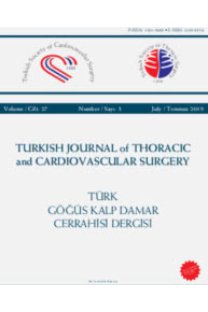Göğüs cerrahisi asistanları cerrahi eğitimleri konusunda ne düşünüyor?
What do residents think regarding the thoracic surgery training?
___
- 1. Türk Tabipler Birliği Ulusal Yeterlilik Kurulu, uzmanlık eğitiminde rehber el kitabı. Ankara: Türk Tabipler Birliği Yayınları; 2006.
- 2. Kösemehmetoğlu K. Gümüşkaya Öcal B. Çoşkunoğlu EZ, Çulha İ, Çiçek AF, Dağlar E ve ark. Patoloji Uzmanlık Eğitimi: Asistan gözüyle. Türk Patoloji Dergisi 2008;24:21-6.
- 3. Mezuniyet öncesi tıp eğitimi grubu toplantısı. Birinci Türk Sağlık Eğitim Şurası; 2000.
- 4. Fish D, Colles C. Medical Education; Developing a Curriculum for practise. Open University Pres; 2005.
- 5. Kern DE, Thomas PA, Hughes MT, Bass EB, editors. Curriculum development for medical education. 1st ed. Baltimore: Johns Hopkins University; 1998.
- 6. World Federation for Medical Education. The Edinburg Decration. Lancet; 1988. p. 8068, 464.
- 7. Salmon K. Associates, formerly. In: Hamilton HMC, editors. Assesment of residency training programs. New York: Hospital Association; 2000.
- 8. WFME Global Standars for Quality Improvement. WFME Office: Denmark: University of Copenhagen; 2003.
- 9. Royal Collage of Physicians and Surgeons of Canada. Canadian M edical E ducation D irections f or S pecialists 2000 Project. Skills for the New Millennium: Report of the Societal Needs Working Group 1996. RCPSC, Ottawa; 2002.
- 10. Commission of the European Communities. Fourth Report and Recommendations on the Conditions for Specialist Training. Doc. XV/E/8306/3/96-EN. Brussels; 1997.
- 11. European Union of Medical Specialists. Charter on Training of Medical Specialist in the European Community. UEMS; 1993.
- 12. Australian Medical Council. Guidlines fort he Acceditation of Medical Specialist Education and Training and Professional Development Programs. Australian Medical Council, Canberra; 2001.
- 13. TTB, uzmanlık dernekleri eşgüdüm kurulu, VII. Tıpta uzmanlık eğitimi kurultayı sonuç bildirgesi. İstanbul; 2001.
- ISSN: 1301-5680
- Yayın Aralığı: Yılda 4 Sayı
- Başlangıç: 1991
- Yayıncı: Bayçınar Tıbbi Yayıncılık
Spontaneous enucleated hydatid cyst with tension pneumothorax: a case report
Aydın NADİR, Şule KARADAYI, Melih KAPTANOĞLU, Ekber ŞAHİN
Unusual presentation of a spontaneous fracture of a first rib: a case report
Walid Abu ARAB, Marco SIROIS, Vincent ECHAVÉ
Koroner endarterektomi ile birlikte yapılan koroner arter baypas greftleme sonuçları
Mehmet ATEŞ, Beşir AKPINAR, Volkan YURTMAN, Veysel ŞAHİN, Feyzi ABACILAR, İhsan Sami UYAR, Faik Fevzi OKUR, Harun EVRENGÜL
Sleeve resection for postlobectomy stump fistulas: a case report
Şükrü DİLEGE, Serhan TANJU, Alper TOKER
Primary cardiac angiosarcoma and diffuse pulmonary hemorrhage: a case report
Ali KÜPELİ, Necmettin YAKUT, Nur YÜCEL, Adnan Kazım USALAN, Tayfun GÖKDOĞAN, Gülru POLAT, Melih BÜYÜKŞİRİN
A case of late postoperative pulmonary arterial hypertension: a rare entity
Bilgehan Savaş ÖZ, Oben BAYSAN, Mehmet YOKUŞOĞLU
A chest wall defect caused by empyema necessitatis due to profound malnutrition
Burçin ÇELİK, Aydın NADİR, Şule KARADAYI, Melih KAPTANOĞLU, Ekber ŞAHİN
Ali SARIGÜL, Erdal EGE, Raşit ÖNOĞLU, Mehmet YAZICI, Cüneyt NARİN
Pain in cardiac surgery and the nursing approach
Ükke KARABACAK, Fatma KORKMAZ DEMİR, Fatma ASLAN ETİ
Brucella endocarditis and its rare complications
Serdar BAYRAK, Levent YILLIK, Cengiz ÖZBEK, Haydar YAŞA, İbrahim ÖZSÖYLER, Ali GÜRBÜZ, Ufuk YETKİN, İsmail YÜREKLİ
